MA115 Project: A Deep Dive into the Life and Work of Isaac Newton
VerifiedAdded on 2023/03/31
|5
|1185
|63
Project
AI Summary
This project is a comprehensive exploration of the life and contributions of Isaac Newton, a pivotal figure in the history of mathematics and science. The student's essay delves into Newton's early life, including his birth in 1642, his upbringing, and his education at Cambridge University. It discusses the influences that inspired his scientific curiosity, particularly his personal drive to understand the universe and the works of scientists like Galileo and Kepler. The project highlights Newton's significant contributions to mathematics, including his work on calculus, the generalized binomial theorem, and the theory of finite differences. It also touches upon his discoveries in optics and physics. The essay further examines the recognition Newton received for his work, both during his lifetime and in the modern era, emphasizing his impact on the scientific community and the enduring relevance of his principles.
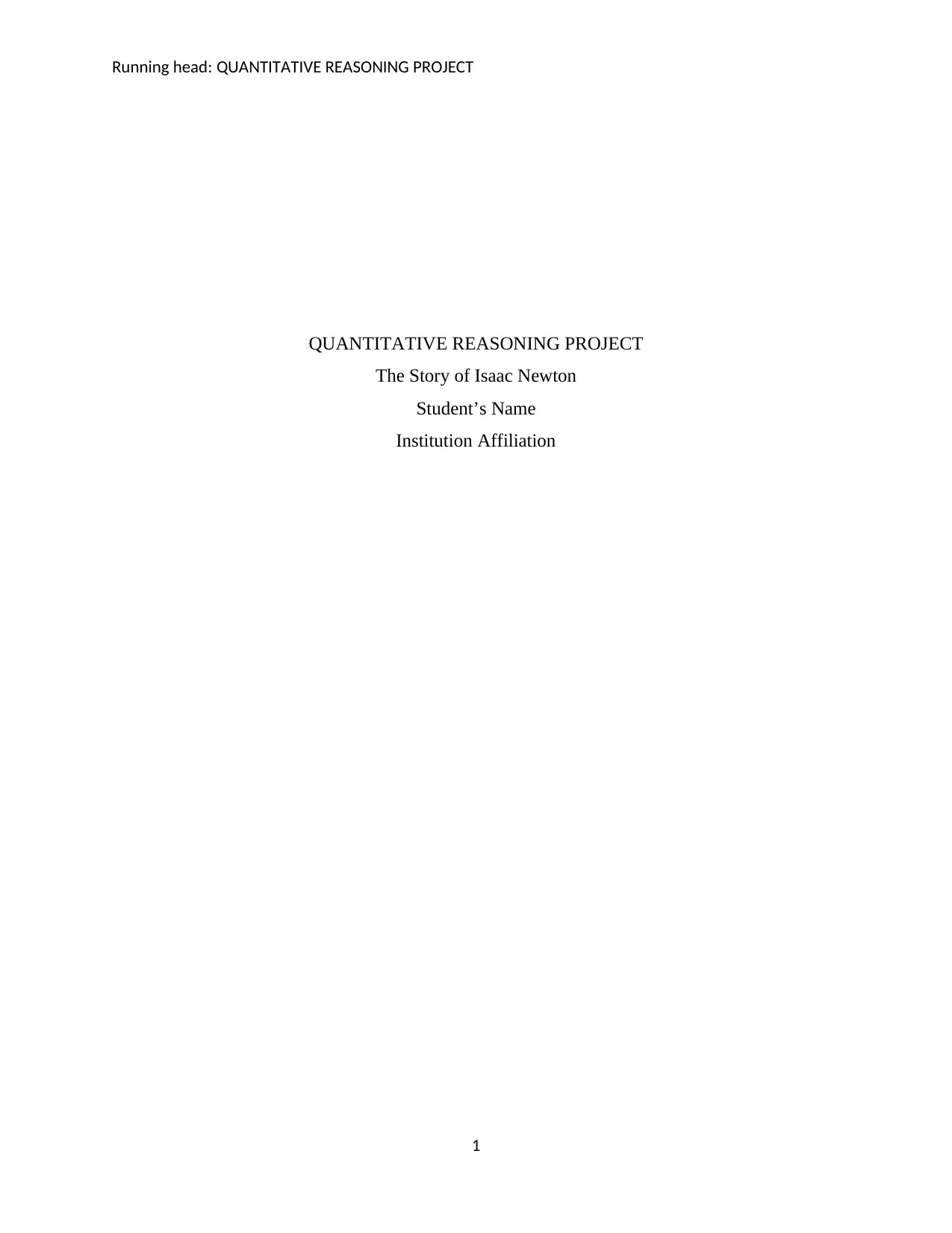
Running head: QUANTITATIVE REASONING PROJECT
QUANTITATIVE REASONING PROJECT
The Story of Isaac Newton
Student’s Name
Institution Affiliation
1
QUANTITATIVE REASONING PROJECT
The Story of Isaac Newton
Student’s Name
Institution Affiliation
1
Paraphrase This Document
Need a fresh take? Get an instant paraphrase of this document with our AI Paraphraser
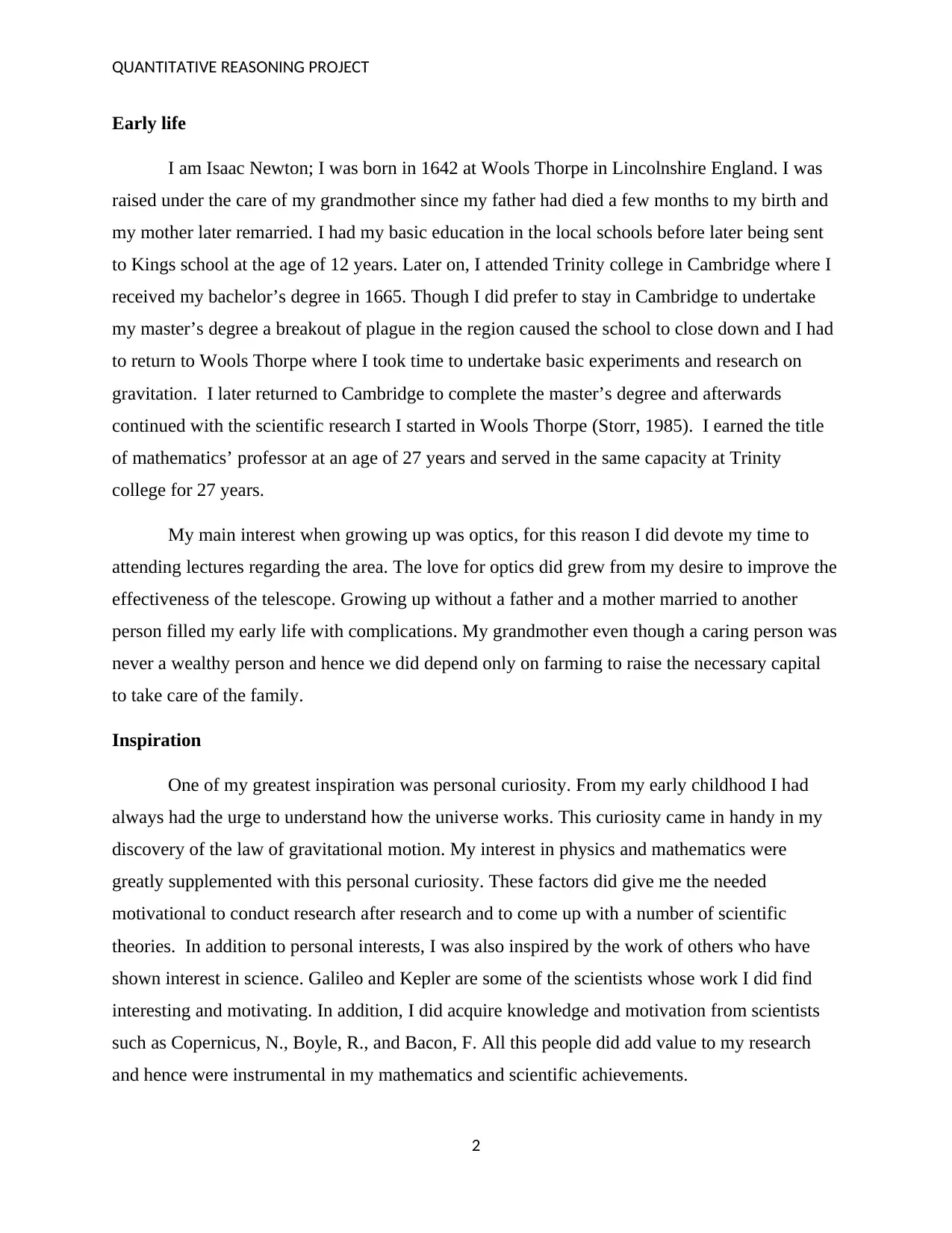
QUANTITATIVE REASONING PROJECT
Early life
I am Isaac Newton; I was born in 1642 at Wools Thorpe in Lincolnshire England. I was
raised under the care of my grandmother since my father had died a few months to my birth and
my mother later remarried. I had my basic education in the local schools before later being sent
to Kings school at the age of 12 years. Later on, I attended Trinity college in Cambridge where I
received my bachelor’s degree in 1665. Though I did prefer to stay in Cambridge to undertake
my master’s degree a breakout of plague in the region caused the school to close down and I had
to return to Wools Thorpe where I took time to undertake basic experiments and research on
gravitation. I later returned to Cambridge to complete the master’s degree and afterwards
continued with the scientific research I started in Wools Thorpe (Storr, 1985). I earned the title
of mathematics’ professor at an age of 27 years and served in the same capacity at Trinity
college for 27 years.
My main interest when growing up was optics, for this reason I did devote my time to
attending lectures regarding the area. The love for optics did grew from my desire to improve the
effectiveness of the telescope. Growing up without a father and a mother married to another
person filled my early life with complications. My grandmother even though a caring person was
never a wealthy person and hence we did depend only on farming to raise the necessary capital
to take care of the family.
Inspiration
One of my greatest inspiration was personal curiosity. From my early childhood I had
always had the urge to understand how the universe works. This curiosity came in handy in my
discovery of the law of gravitational motion. My interest in physics and mathematics were
greatly supplemented with this personal curiosity. These factors did give me the needed
motivational to conduct research after research and to come up with a number of scientific
theories. In addition to personal interests, I was also inspired by the work of others who have
shown interest in science. Galileo and Kepler are some of the scientists whose work I did find
interesting and motivating. In addition, I did acquire knowledge and motivation from scientists
such as Copernicus, N., Boyle, R., and Bacon, F. All this people did add value to my research
and hence were instrumental in my mathematics and scientific achievements.
2
Early life
I am Isaac Newton; I was born in 1642 at Wools Thorpe in Lincolnshire England. I was
raised under the care of my grandmother since my father had died a few months to my birth and
my mother later remarried. I had my basic education in the local schools before later being sent
to Kings school at the age of 12 years. Later on, I attended Trinity college in Cambridge where I
received my bachelor’s degree in 1665. Though I did prefer to stay in Cambridge to undertake
my master’s degree a breakout of plague in the region caused the school to close down and I had
to return to Wools Thorpe where I took time to undertake basic experiments and research on
gravitation. I later returned to Cambridge to complete the master’s degree and afterwards
continued with the scientific research I started in Wools Thorpe (Storr, 1985). I earned the title
of mathematics’ professor at an age of 27 years and served in the same capacity at Trinity
college for 27 years.
My main interest when growing up was optics, for this reason I did devote my time to
attending lectures regarding the area. The love for optics did grew from my desire to improve the
effectiveness of the telescope. Growing up without a father and a mother married to another
person filled my early life with complications. My grandmother even though a caring person was
never a wealthy person and hence we did depend only on farming to raise the necessary capital
to take care of the family.
Inspiration
One of my greatest inspiration was personal curiosity. From my early childhood I had
always had the urge to understand how the universe works. This curiosity came in handy in my
discovery of the law of gravitational motion. My interest in physics and mathematics were
greatly supplemented with this personal curiosity. These factors did give me the needed
motivational to conduct research after research and to come up with a number of scientific
theories. In addition to personal interests, I was also inspired by the work of others who have
shown interest in science. Galileo and Kepler are some of the scientists whose work I did find
interesting and motivating. In addition, I did acquire knowledge and motivation from scientists
such as Copernicus, N., Boyle, R., and Bacon, F. All this people did add value to my research
and hence were instrumental in my mathematics and scientific achievements.
2
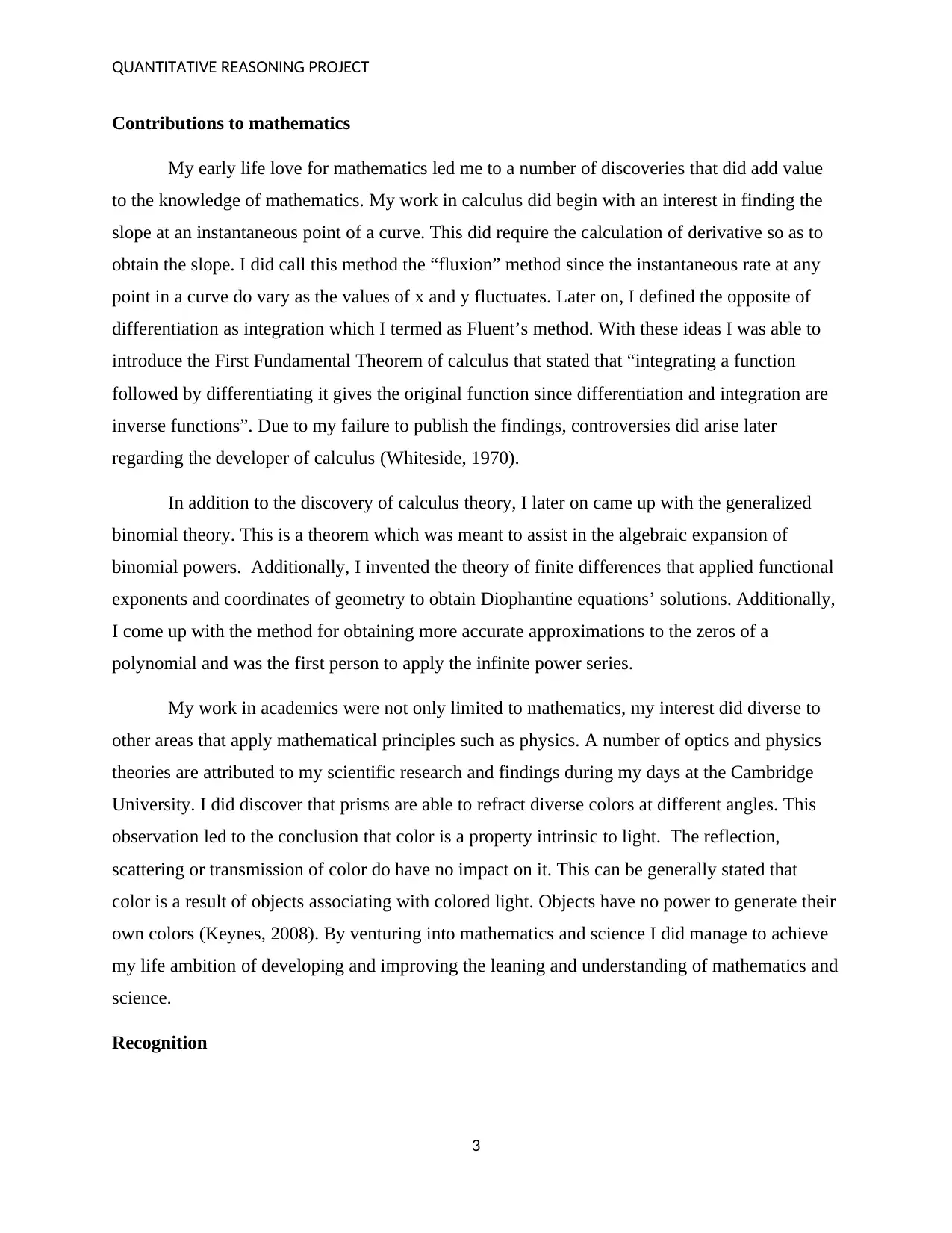
QUANTITATIVE REASONING PROJECT
Contributions to mathematics
My early life love for mathematics led me to a number of discoveries that did add value
to the knowledge of mathematics. My work in calculus did begin with an interest in finding the
slope at an instantaneous point of a curve. This did require the calculation of derivative so as to
obtain the slope. I did call this method the “fluxion” method since the instantaneous rate at any
point in a curve do vary as the values of x and y fluctuates. Later on, I defined the opposite of
differentiation as integration which I termed as Fluent’s method. With these ideas I was able to
introduce the First Fundamental Theorem of calculus that stated that “integrating a function
followed by differentiating it gives the original function since differentiation and integration are
inverse functions”. Due to my failure to publish the findings, controversies did arise later
regarding the developer of calculus (Whiteside, 1970).
In addition to the discovery of calculus theory, I later on came up with the generalized
binomial theory. This is a theorem which was meant to assist in the algebraic expansion of
binomial powers. Additionally, I invented the theory of finite differences that applied functional
exponents and coordinates of geometry to obtain Diophantine equations’ solutions. Additionally,
I come up with the method for obtaining more accurate approximations to the zeros of a
polynomial and was the first person to apply the infinite power series.
My work in academics were not only limited to mathematics, my interest did diverse to
other areas that apply mathematical principles such as physics. A number of optics and physics
theories are attributed to my scientific research and findings during my days at the Cambridge
University. I did discover that prisms are able to refract diverse colors at different angles. This
observation led to the conclusion that color is a property intrinsic to light. The reflection,
scattering or transmission of color do have no impact on it. This can be generally stated that
color is a result of objects associating with colored light. Objects have no power to generate their
own colors (Keynes, 2008). By venturing into mathematics and science I did manage to achieve
my life ambition of developing and improving the leaning and understanding of mathematics and
science.
Recognition
3
Contributions to mathematics
My early life love for mathematics led me to a number of discoveries that did add value
to the knowledge of mathematics. My work in calculus did begin with an interest in finding the
slope at an instantaneous point of a curve. This did require the calculation of derivative so as to
obtain the slope. I did call this method the “fluxion” method since the instantaneous rate at any
point in a curve do vary as the values of x and y fluctuates. Later on, I defined the opposite of
differentiation as integration which I termed as Fluent’s method. With these ideas I was able to
introduce the First Fundamental Theorem of calculus that stated that “integrating a function
followed by differentiating it gives the original function since differentiation and integration are
inverse functions”. Due to my failure to publish the findings, controversies did arise later
regarding the developer of calculus (Whiteside, 1970).
In addition to the discovery of calculus theory, I later on came up with the generalized
binomial theory. This is a theorem which was meant to assist in the algebraic expansion of
binomial powers. Additionally, I invented the theory of finite differences that applied functional
exponents and coordinates of geometry to obtain Diophantine equations’ solutions. Additionally,
I come up with the method for obtaining more accurate approximations to the zeros of a
polynomial and was the first person to apply the infinite power series.
My work in academics were not only limited to mathematics, my interest did diverse to
other areas that apply mathematical principles such as physics. A number of optics and physics
theories are attributed to my scientific research and findings during my days at the Cambridge
University. I did discover that prisms are able to refract diverse colors at different angles. This
observation led to the conclusion that color is a property intrinsic to light. The reflection,
scattering or transmission of color do have no impact on it. This can be generally stated that
color is a result of objects associating with colored light. Objects have no power to generate their
own colors (Keynes, 2008). By venturing into mathematics and science I did manage to achieve
my life ambition of developing and improving the leaning and understanding of mathematics and
science.
Recognition
3
⊘ This is a preview!⊘
Do you want full access?
Subscribe today to unlock all pages.

Trusted by 1+ million students worldwide
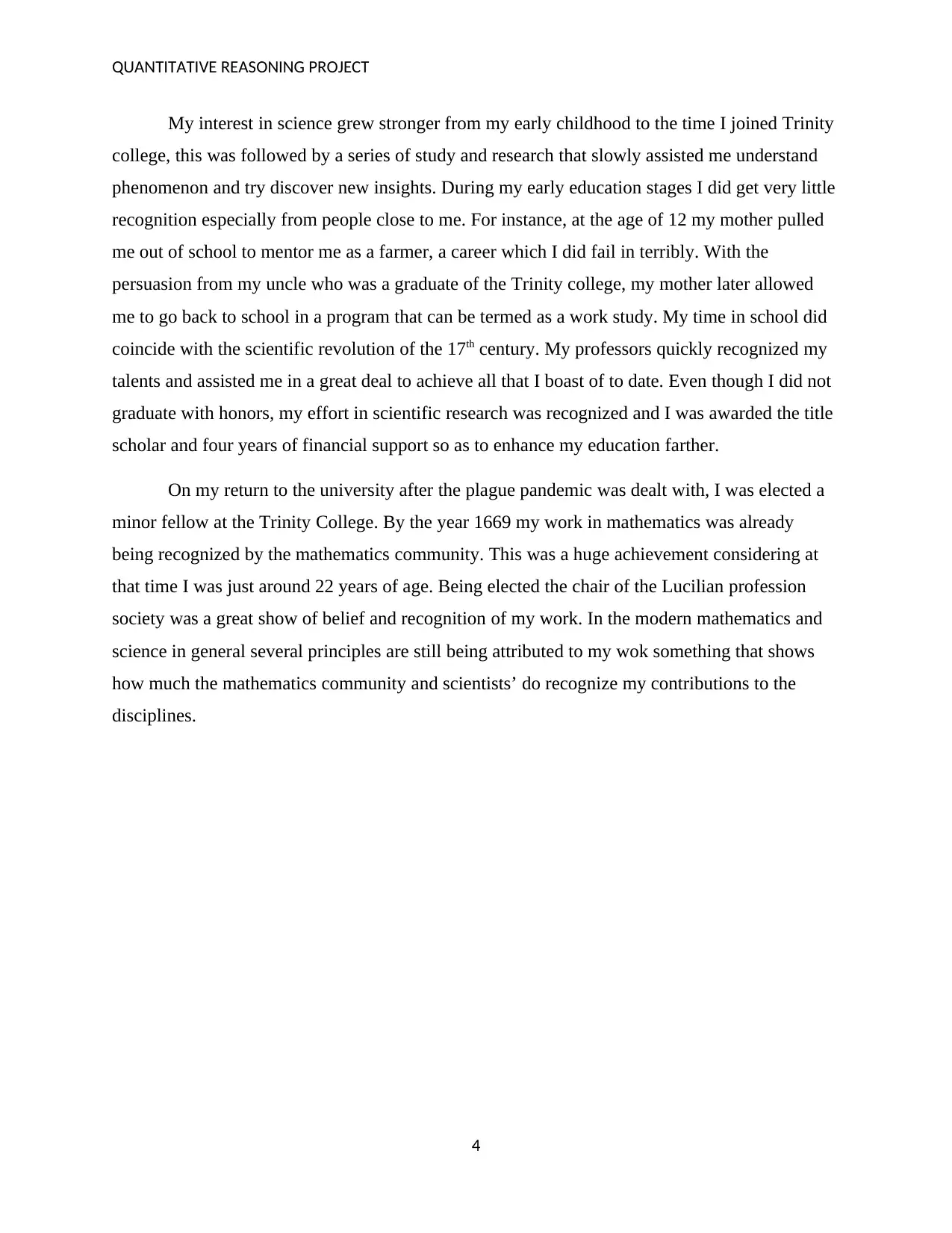
QUANTITATIVE REASONING PROJECT
My interest in science grew stronger from my early childhood to the time I joined Trinity
college, this was followed by a series of study and research that slowly assisted me understand
phenomenon and try discover new insights. During my early education stages I did get very little
recognition especially from people close to me. For instance, at the age of 12 my mother pulled
me out of school to mentor me as a farmer, a career which I did fail in terribly. With the
persuasion from my uncle who was a graduate of the Trinity college, my mother later allowed
me to go back to school in a program that can be termed as a work study. My time in school did
coincide with the scientific revolution of the 17th century. My professors quickly recognized my
talents and assisted me in a great deal to achieve all that I boast of to date. Even though I did not
graduate with honors, my effort in scientific research was recognized and I was awarded the title
scholar and four years of financial support so as to enhance my education farther.
On my return to the university after the plague pandemic was dealt with, I was elected a
minor fellow at the Trinity College. By the year 1669 my work in mathematics was already
being recognized by the mathematics community. This was a huge achievement considering at
that time I was just around 22 years of age. Being elected the chair of the Lucilian profession
society was a great show of belief and recognition of my work. In the modern mathematics and
science in general several principles are still being attributed to my wok something that shows
how much the mathematics community and scientists’ do recognize my contributions to the
disciplines.
4
My interest in science grew stronger from my early childhood to the time I joined Trinity
college, this was followed by a series of study and research that slowly assisted me understand
phenomenon and try discover new insights. During my early education stages I did get very little
recognition especially from people close to me. For instance, at the age of 12 my mother pulled
me out of school to mentor me as a farmer, a career which I did fail in terribly. With the
persuasion from my uncle who was a graduate of the Trinity college, my mother later allowed
me to go back to school in a program that can be termed as a work study. My time in school did
coincide with the scientific revolution of the 17th century. My professors quickly recognized my
talents and assisted me in a great deal to achieve all that I boast of to date. Even though I did not
graduate with honors, my effort in scientific research was recognized and I was awarded the title
scholar and four years of financial support so as to enhance my education farther.
On my return to the university after the plague pandemic was dealt with, I was elected a
minor fellow at the Trinity College. By the year 1669 my work in mathematics was already
being recognized by the mathematics community. This was a huge achievement considering at
that time I was just around 22 years of age. Being elected the chair of the Lucilian profession
society was a great show of belief and recognition of my work. In the modern mathematics and
science in general several principles are still being attributed to my wok something that shows
how much the mathematics community and scientists’ do recognize my contributions to the
disciplines.
4
Paraphrase This Document
Need a fresh take? Get an instant paraphrase of this document with our AI Paraphraser
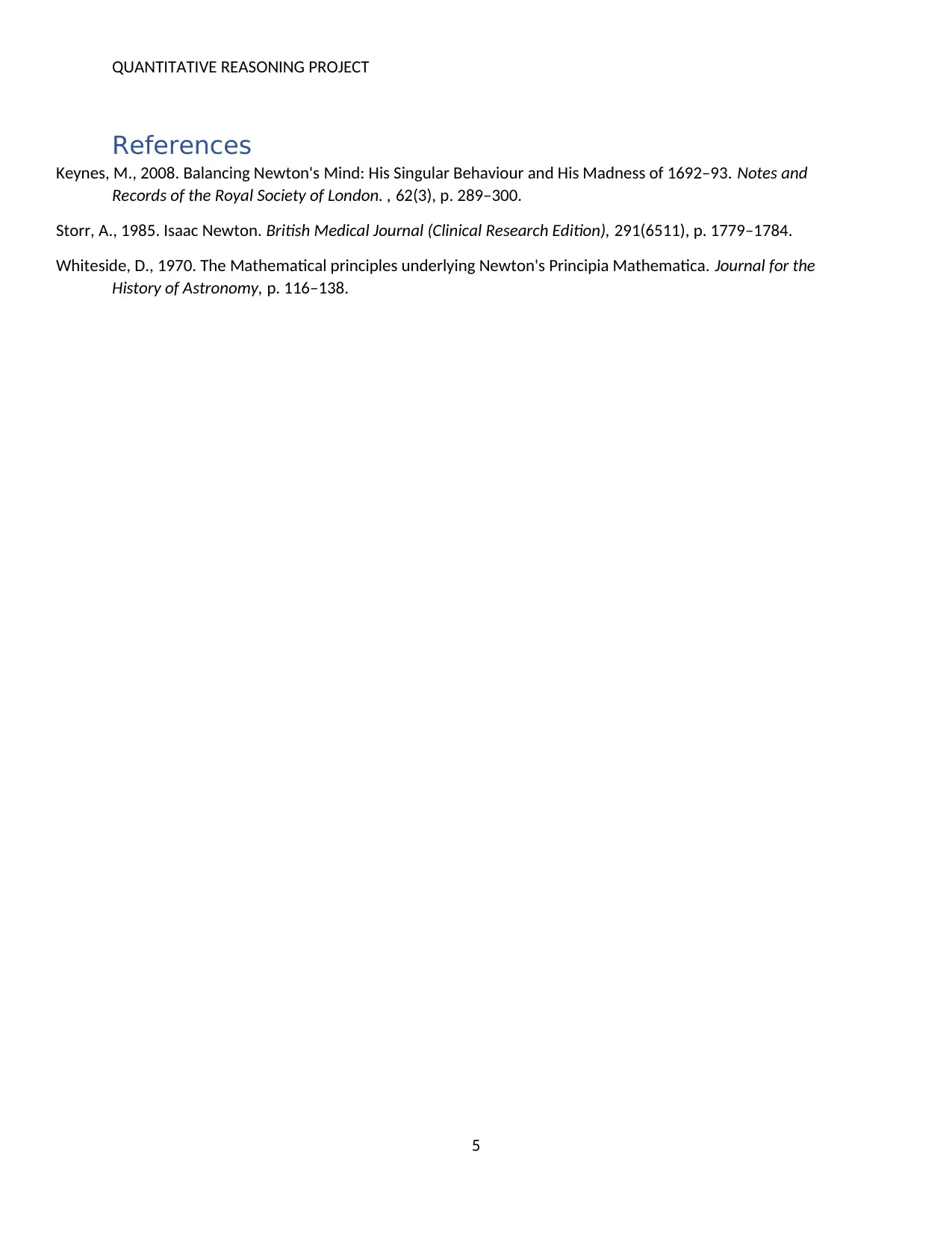
QUANTITATIVE REASONING PROJECT
References
Keynes, M., 2008. Balancing Newton's Mind: His Singular Behaviour and His Madness of 1692–93. Notes and
Records of the Royal Society of London. , 62(3), p. 289–300.
Storr, A., 1985. Isaac Newton. British Medical Journal (Clinical Research Edition), 291(6511), p. 1779–1784.
Whiteside, D., 1970. The Mathematical principles underlying Newton's Principia Mathematica. Journal for the
History of Astronomy, p. 116–138.
5
References
Keynes, M., 2008. Balancing Newton's Mind: His Singular Behaviour and His Madness of 1692–93. Notes and
Records of the Royal Society of London. , 62(3), p. 289–300.
Storr, A., 1985. Isaac Newton. British Medical Journal (Clinical Research Edition), 291(6511), p. 1779–1784.
Whiteside, D., 1970. The Mathematical principles underlying Newton's Principia Mathematica. Journal for the
History of Astronomy, p. 116–138.
5
1 out of 5
Your All-in-One AI-Powered Toolkit for Academic Success.
+13062052269
info@desklib.com
Available 24*7 on WhatsApp / Email
![[object Object]](/_next/static/media/star-bottom.7253800d.svg)
Unlock your academic potential
Copyright © 2020–2025 A2Z Services. All Rights Reserved. Developed and managed by ZUCOL.
